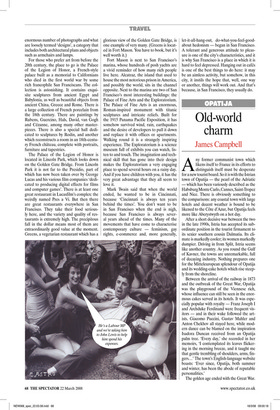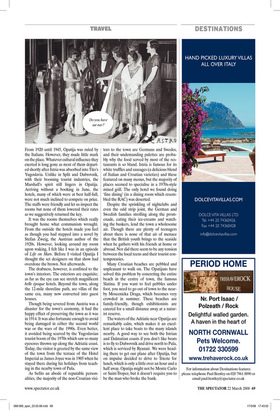Old-world charm
James Campbell
Any former communist town which likens itself to France in its efforts to distinguish itself must be desperate for a new tourist board. So it is with the Istrian town of Opatija — the pearl of the Adriatic — which has been variously described as the Habsburg Monte Carlo, Cannes, Saint-Tropez and Nice. There is obviously something to the comparisons: any coastal town with large hotels and decent weather is bound to be likened to the Côte d’Azur, but Opatija feels more like Aberystwyth on a hot day.
After a short decisive war between the two in the late 1990s, Istria has accepted its subordinate position in the tourist firmament to its sexier southern cousin Dalmatia. Its climate is markedly cooler; its women markedly dumpier. Driving in from Split, Istria seems like another country. As you round the Gulf of Kavner, the towns are unremarkable, full of decaying industry. Nothing prepares one for the Mitteleuropean splendour of Opatija and its wedding-cake hotels which rise steeply from the shoreline.
Between the arrival of the railway in 1873 and the outbreak of the Great War, Opatija was the playground of the Viennese rich, whose influence can still be seen in the enormous cakes served in its hotels. It was especially popular with royalty — Franz Joseph I and Archduke Ferdinand were frequent visitors — and in their wake followed the artists. Giacomo Puccini, Gustav Mahler and Anton Chekhov all stayed here, while modern dance can be blamed on the inspiration Isadora Duncan received from an Opatija palm tree. ‘Every day,’ she recorded in her memoirs, ‘I contemplated its leaves flickering in the morning breeze, and it taught me that gentle trembling of shoulders, arms, fingers...’ The town’s English-language website boasts: ‘Ever since, Opatija, both summer and winter, has been the abode of reputable personalities.’ The golden age ended with the Great War. From 1920 until 1945, Opatija was ruled by the Italians. However, they made little mark on the place. Whatever cultural influence they exerted is long gone as most of them departed shortly after Istria was absorbed into Tito’s Yugoslavia. Unlike in Split and Dubrovnik, with their booming tourist industries, the Marshall’s spirit still lingers in Opatija. Arriving without a booking in June, the hotels, many of which were at best half-full, were not much inclined to compete on price. The staffs were friendly and let us inspect the rooms but none of them lowered their rates as we suggestively returned the key.
It was the rooms themselves which really brought home what communism wrought. From the outside the hotels made you feel as though you had stepped into a novel by Stefan Zweig, the Austrian author of the 1920s. However, looking around my room upon waking, I felt like I was in an episode of Life on Mars. Before I visited Opatija I thought the set designers on that show had overdone the brown. Not afterwards.
The drabness, however, is confined to the town’s interiors. The exteriors are exquisite; as far as the eye can see stretch magnificent belle époque hotels. Beyond the town, along the 12-mile shoreline path, are villas of the same era, many now converted into guest houses.
Though being severed from Austria was a disaster for the town’s economy, it had the happy effect of preserving the town as it was in 1914. It was also fortunate enough to avoid being damaged in either the second world war or the wars of the 1990s. Even better, it avoided being scarred by the Yugoslavian tourist boom of the 1970s which saw so many eyesores thrown up along the Adriatic coast. Today, the visitor is greeted by the same view of the town from the terrace of the Hotel Imperial as James Joyce was in 1905 when he stayed there during his holidays from teaching in the nearby town of Pula.
As befits an abode of reputable personalities, the majority of the non-Croatian visi tors to the town are Germans and Swedes, and their undemanding palettes are probably why the food served by most of the restaurants is so bland. Istria is famous for its white truffles and sausages (a delicious blend of Italian and Croatian varieties) and these featured on many menus, but the majority of places seemed to specialise in a 1970s-style mixed grill. The only hotel we found doing ‘fine dining’ (in a dining room which resembled the RAC) was deserted.
Despite the sprinkling of nightclubs and even the odd strip joint, the German and Swedish families strolling along the promenade, eating their ice-creams and watching the buskers, lend the town a wholesome air. Though there are plenty of teenagers about there is none of that air of menace that the British youth brings to the seaside when he gathers with his friends at home or abroad. Nor did there seem to be any tension between the local teens and their tourist contemporaries.
Many Croatian beaches are pebbled and unpleasant to walk on. The Opatijans have solved this problem by concreting the entire beach in the centre of town, the famous Slatina. If you want to feel pebbles under foot, you need to go out of town to the nearby Moscenicka Draga, which becomes very crowded in summer. These beaches are family-friendly, though exhibitionists are catered for a small distance away at a naturist reserve.
The waters of the Adriatic near Opatija are remarkably calm, which makes it an excellent place to take boats to the many islands nearby. A good way to see both the Istrian and Dalmatian coasts if you don’t like boats is to fly to Dubrovnik and drive north to Pula, which is serviced by Ryanair. We were heading there to get our plane after Opatija, but on impulse decided to drive to Trieste for lunch, which is only a little over an hour and a half away. Opatija might not be Monte Carlo or Saint-Tropez, but it doesn’t require you to be the man who broke the bank.



















































































 Previous page
Previous page